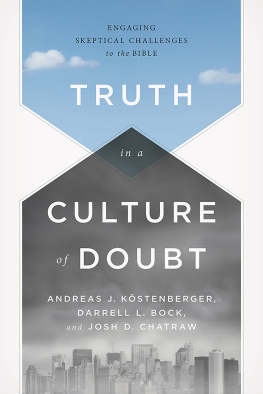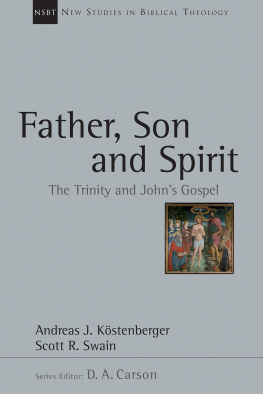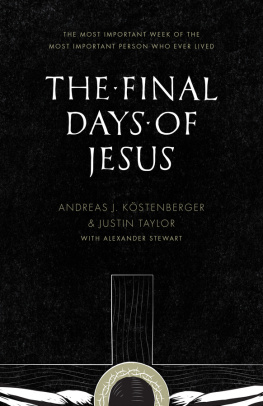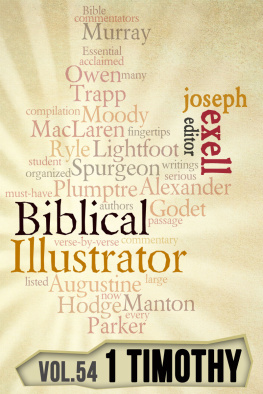AN ANALYSIS AND APPLICATION OF 1 TIMOTHY 2:9-15
S E C O N D E D I T I O N
EDITED BY
ANDREAS J. KOSTENBERGER AND THOMAS R. SCHREINER



S. M. Baugh
Henry Scott Baldwin
Andreas J. Kostenberger
Thomas R. Schreiner
Robert W. Yarbrough
Dorothy Kelley Patterson
Henry Scott Baldwin (Ph.D., Trinity Evangelical Divinity School) is associate professor of New Testament literature and language at Tyndale Theological Seminary, Amsterdam, Netherlands.
S. M. Baugh (Ph.D., University of California, Irvine) is professor of New Testament at Westminster Seminary California, Escondido, California.
Andreas J. Kostenberger (Ph.D., Trinity Evangelical Divinity School) is professor of New Testament and Greek and director of Ph.D./ Th.M. studies at Southeastern Baptist Theological Seminary, Wake Forest, North Carolina.
Dorothy Kelley Patterson (Th.D., University of South Africa) is professor of theology in women's studies at Southwestern Baptist Theological Seminary, Fort Worth, Texas.
Thomas R. Schreiner (Ph.D., Fuller Theological Seminary) is professor of New Testament interpretation and associate dean for Scripture and interpretation at The Southern Baptist Theological Seminary, Louisville, Kentucky.
Robert W. Yarbrough (Ph.D., University of Aberdeen) is associate professor of New Testament and department chair at Trinity Evangelical Divinity School, Deerfield, Illinois.
 en years after the publication of the first edition of Women in the Church, the debate over women's roles in the church is as fierce as it has ever been. Not that significant new biblical information has come to light-Scripture does not change, and no major new data have been discovered that have a bearing on the interpretation of 1 Timothy 2:915-but the larger culture continues to press on the church to recognize women as men's equals without any distinctions in function or role.
en years after the publication of the first edition of Women in the Church, the debate over women's roles in the church is as fierce as it has ever been. Not that significant new biblical information has come to light-Scripture does not change, and no major new data have been discovered that have a bearing on the interpretation of 1 Timothy 2:915-but the larger culture continues to press on the church to recognize women as men's equals without any distinctions in function or role.
For this reason the witness to the teaching of Scripture borne by the present volume in our politically correct context with its largely egalitarian worldview continues to be both timely and needed. To enhance the work's usefulness, material judged to be less central to the overall argument of the book has been omitted, while a new chapter on application has been added. All included essays have been updated in light of recent developments in scholarship pertaining to the interpretation of 1 Timothy 2:9-15.
In the new streamlined format of the argument of Women in the Church, Steven Baugh continues to maintain that first-century Ephesus was not a feminist society, so that egalitarian attempts to construe the present passage as Paul's effort to counteract unruly women in this city in Asia Minor are without a proper foundation. The chapters by Henry Baldwin and Andreas Kostenberger on the meaning of av9evTeco and the Greek syntax of 1 Timothy 2:12 have held up well under ten years of critical scrutiny. They are included here again in an updated format.
The second half of the book is devoted to a thorough verse-by-verse commentary on 1 Timothy 2:9-15; principles guiding the interpretation of the present passage; and a new chapter on the application of its teachings by Dorothy Patterson. As a woman who has been involved in significant ministry for several decades, Dr. Patterson is highly qualified to comment on the passage's implications for women's roles in the church. She argues that women ought to exercise their God-given spiritual gifts within biblical parameters in obedience to God.
It is the desire of the editors and contributors to this volume that the teachings of Scripture on this vital topic will continue to be upheld and commended to all those who sincerely seek God's guidance. May women of any age who seek the Lord on how to serve him find a reliable word from God in the pages of this book. And may pastors whom God has put in charge of teaching his Word and of leading congregations in the truth be equipped to know and be encouraged to communicate biblical truth in this critical area.
To he sure, the tempter will continue to whisper into women's ears, "Has God really said ... ?" But contrary to the devil's charge, the boundaries set by God are good, intending to enhance, rather than harm, women's fulfillment as they live out their God-given roles. It would clearly he unrealistic to expect a world that misconstrues equality as sameness and that seeks to erode any meaningful distinction between male and female (witness the push toward gay marriage) to embrace the biblical counsel on male-female roles and relationships.
But it should he different with those in the church. As the present volume makes clear, all the various elements affecting the interpretation of I Timothy 2:9-15 combine to suggest that it is not God's will for women to teach or have authority over men in the church, so that the offices of pastor-teacher as well as elder ought to be reserved for men. These elements are the first-century background, the meaning of au9svieco and the Greek syntax of 1 Timothy 2:12, the interpretation of 1 Timothy 2:9-15 in its proper context, and proper principles of interpretation.
As you read this hook, may God the Holy Spirit guide you to have not only a mind to understand but also the will to obey the teaching of the present passage, and may you find that personal fulfillment comes, not from rebelling against God's will, but from obeying it. Soli Deo gloria.
Andreas J. Kostenberger
Thomas R. Schreiner






























 en years after the publication of the first edition of Women in the Church, the debate over women's roles in the church is as fierce as it has ever been. Not that significant new biblical information has come to light-Scripture does not change, and no major new data have been discovered that have a bearing on the interpretation of 1 Timothy 2:915-but the larger culture continues to press on the church to recognize women as men's equals without any distinctions in function or role.
en years after the publication of the first edition of Women in the Church, the debate over women's roles in the church is as fierce as it has ever been. Not that significant new biblical information has come to light-Scripture does not change, and no major new data have been discovered that have a bearing on the interpretation of 1 Timothy 2:915-but the larger culture continues to press on the church to recognize women as men's equals without any distinctions in function or role.